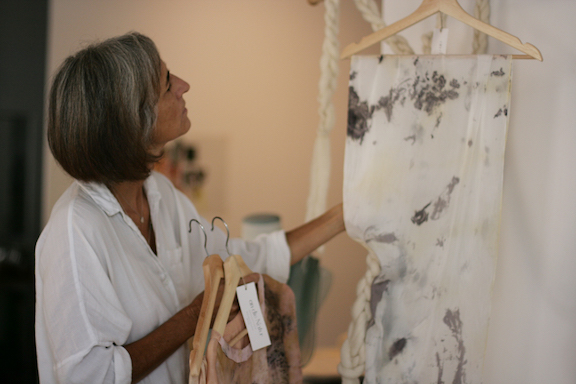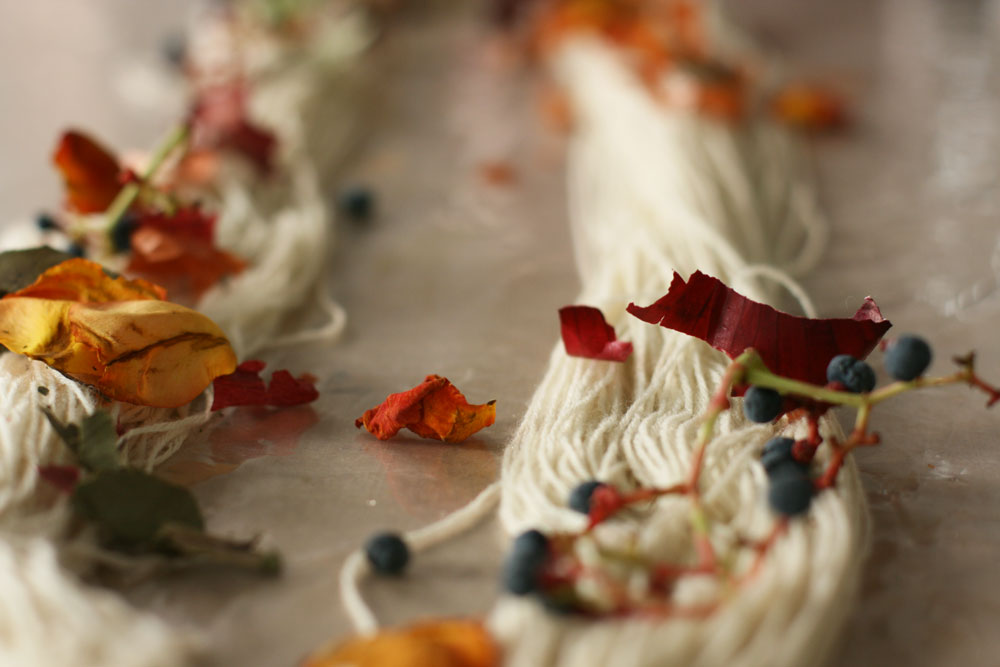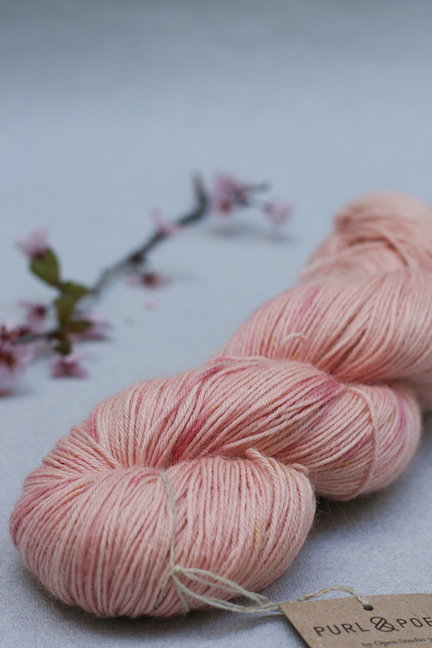Tatiana Sarasa’s art connects her with the earth. That connection gives her so much satisfaction that she promotes the connection through her own work and by providing a collaborative workspace for other artists.

Tell us a little bit about you and what you do.
I am a visual artist and natural dyer: a person who believes in trying to have a better relationship as humans and species in our habitat, which is Mother Earth.
How did you find yourself on an artist’s path? Always there? Lightbulb moment? Dragged kicking and screaming? Evolving?
I have to admit that since childhood I loved to squeeze juices out of petals and plants, cooking color or playing with sand and soil. My hands were always making and they haven’t stopped since then. After studying to be a dental technician I went to the University of Arts in Barcelona, my hometown, and got my degree in Fine Arts. Since then I have been active in the Art scene but also with my project OPEN STUDIO 79, trying to share values and ideas. Talking to people through my work, which is very much connected to my moment in life and the circumstances that surround them.
As an Amazon Associate I earn from qualifying purchases. Read more about our affiliate linking policy.

Do you think that creativity is part of human nature or is it something that must be nurtured and learned?
I definitely think we are all creative beings. Just watch children and see how they play and are able to imagine things. But of course creativity has to be trained. Is is like a muscle that needs to be exercised. We need creativity in our lives to solve problems in an ingenious way, but also to feed our heart and souls. I wonder how much harm electronic devices do to children who do have not time to become bored and are constantly stimulated in an artificial way.

How does living on the island of Mallorca influence your art? Is your work different on the island compared to Barcelona?
Mallorca is a very special place. It is amazing, surrounded by blue waters and filled with stunning landscapes. The light is beautiful and nature feels very close, which is very nice when working with plants and their dyes. I think the island has influenced me a lot in my work. I am worried though how the island is exhausting and how the natural resources and land are being affected through an excess of people, rental cars, airplanes, cruise ships.
But I think this is already a universal problem, happening in many parts of the world. Barcelona too… For sure if I had stayed there my work would had shifted in another direction. I remember as a teenager never wanting to leave the city and its intense life. Perhaps I would have evolved in the art and design scene differently and expressed myself according to it. Now as I grow older, living close to nature is more enriching to me and what I am craving. I imagine myself retiring on a little farm and studio where I can work and share my experience with others.

How do you make the connection between art and nature?
It comes in a very natural way. Nature offers me inspiration, colors and this special energy. I try to find permission in its elements to talk through her and express myself. We have forgotten that we are part of nature and through my work as a natural dyer or through my art pieces I try to bring nature closer to me and to you.

Tell us about Open Studio 79. What do you hope to achieve there?
Open Studio 79 is a textile studio, shop and Artisan Lab, but it is mainly a space to share values. Concepts as sustainable materials, time, craftsmanship and handmade is what I want to hand over to the people entering my space. I want to talk about buying less, but better, about intelligent austerity, about preservation of culture and landscape. It is beautiful to see how more and more people are visiting us and how the sensitivity is growing for these types of values, and this is the best reward ever.

How does your studio organization contribute to your work process?
My studio is a fluctuating space and things melt up within. Though there is a studio shop at the entrance of OS79, people can come in and see us work at the loom, or sewing or walking into the back part where I have my dye studio and little patio. We have restricted opening hours for the studio shop, but we are all day in working on our different projects.

I share the studio with the textile artist and weaver Mariana Muravito, and we get much inspiration and joy one from another. We have great conversations and laughs at our coffee breaks.

What are the indispensable tools and materials in your studio? How do they improve your work?
First of all, raw materials such as flowers, leaves, branches, avocado pits, onion skins or barks. I pick them from my tiny garden, on my walk to the studio, at weekend excursions, from the juice bar next door or local food market.
Pots and fire, looms, spinning wheels, sewing machines or knitting needles, my Japanese brushes are all important tools. And of course my hands and mood. I love to have a calm waking up at home, enjoying the garden, breakfast and then I am ready to walk down to the studio and work all day.

What is your favourite lesser-known tool for your trade? Have you taken something designed for another use and repurposed it for your studio?
Perhaps in my case it is my particular way of printing the color of leaves, flowers or berries on yarns. I use a special eco print technique and make little bundles tied in fabric. There is no tool involved, but it is my own special way of doing and creating. I did very interesting eco print workshops by The Wild Dyery and am using many learned techniques to apply my own way on yarns.

What inspires you? Are there recurring themes in your work?
Colors of nature are to me the most inspiring, but also the texture of hand spun wool or yarns. Actually it is what I sense and feel that puts me into action. I am quite intuitive working and love how things unfold or come together in a magic way. I try to be alert to what my heart says and make accordingly.
But I can not deny that I feel very attracted to Japanese culture and its craftsmanship. This year I had the chance to visit the country on a Textile Tour, do workshops, meet artisans in some remote villages and dig my hands into blue (indigo)….and it was the most inspiring trip ever. On the contrary when I am working on my art installations it is more about thoughts and ideas that I transform into physical creations. In this case the inspiration comes from what is happening around me, in the world.

How has your creativity has evolved over the years? What triggered the evolution to new mediums/kinds of work/ways of working?
Besides my journey as a visual artist, when I decided to open my art studio and transform it into a place of sharing, while offering workshops I got the chance to meet someone very special who introduced me into the world of natural dyes. I learned to see color in a different way and got seduced by the magic of the process, the beautiful connection that one establishes to nature and landscape. Since then I have not stopped experimenting and learning. I have my own line of botanical dyed yarns called Purl & Poem and hand dyed textiles and scarves: An die Natur. I always say that the more you know, the more you realize how much there is still to discover. It is fascinating.


Another thing that influenced my creative journey was when I became a mother and picked up my knitting needles. It allowed me to make and create from home while I was not able to spend time at my studio. Knitting was soothing and the rhythmic movement of the needles was like saying a mantra to me. It became an important part of my life and also of my a career as an artist, incorporating knitted pieces into my work. And of course I am a yarn dyer too…guess why?? 🙂

What was the biggest challenge that you encountered on your creative journey? What did you learn from it?
When working with natural colors it is all about experimentation. Of course there are many recipes that I use and that work, but I always love to stay very playful and find new ways, try different plants and cook new shades of color. I learned that the results are many times unpredictable. You can obtain different shades of the same plant, regarding the season you picked it, or the quality of the water, or the time your fiber stayed in the dye bath. But this is something I truly enjoy. The uniqueness of each piece and process. Letting go our obsession to control nature, going with the seasons and getting a bit wild.

Which of your creative accomplishments gave you the most satisfaction, and why?
The satisfaction lies in me within the process. Of course I love when I create a beautiful design or put together an laborious art installation. But the making itself is really my greatest joy.
I have to say though that I feel proud of some of my art installations, like one dedicated to the English writer Virginia Woolf, where I created a room out of fabric and hand cut paper, with a knitted river that invaded the Gallery space.



Also one of my last pieces that talks about our relationship to clothing and is composed by 6 knitted pullover with a quote written on them. I love to use fiber in my art work and use its qualities to talk through it.

When engaged in a creative activity, do you usually have specific goals, or does the work evolve?
I usually like to envision where I am going design-wise and also to think about the purpose of what I am creating. But while making I love to be flexible, embrace accidents, or let things flow in a natural way. As I work with my hands, but also with natural materials, which have their own character and energy, one has to be open for things to happen. Making is this beautiful conversation between your heart, hands and the materials you are working with.

How many projects do you have going at once? Or do you focus on one creative project at a time?
Oh…. sometimes too many. Running the studio and business is already a work by itself. Then there is my own work as dyer, maker or artist. I wish I could focus only on one thing, but unfortunately I have always several projects going on. I have to split up and organize my time, but I try to enjoy each work or project in full. Be present, open up my senses and enjoy the nature of each movement, the vibration of color or the touch and texture of fiber.
Which artists do you admire? What draws you to their work?
There are many I could list right now, but I will pick three. The artist Ann Hamilton and her large scale installations that are full of poetry to me. The Japanese artist Chiaru Shiota, who does large scale installations with complex networks of yarn.
And then the third, or put it on the first place on the lists, would be all the artisans of the world in present and past times. I feel great admiration for them and think that it is important to make a tribute to them. For their humbleness, their know-how, and their preservation of values like effort, skills, nature, time and culture. So many have stayed anonymous, but are an important part of our history and evolution. Thank you to all of them.

What areas of your work do you hope to explore further?
Perhaps what moves me is to focus even more on sharing values through my making. Opening more conversations about what we need, how we consume and how to move back to a more austere way of living.
Having fewer but more meaningful pieces. That means in my work focusing more on the intention than on the quantity. It is not easy though, as self-employed, to make a living with your hand made pieces and pay your taxes. Governments should support the work of artisans and artists more because they are important.
I would love to use the quote by the American singer and songwriter Amanda Palmer who said: “Art is food for the soul. An artistic climate is a healthy climate, because it breeds empathy. ”
Learn more about Tatiana on her website.
Interview posted August 2019
Browse through more inspiring Eco-friendly printing and dyeing artists and projects on Create Whimsy.
